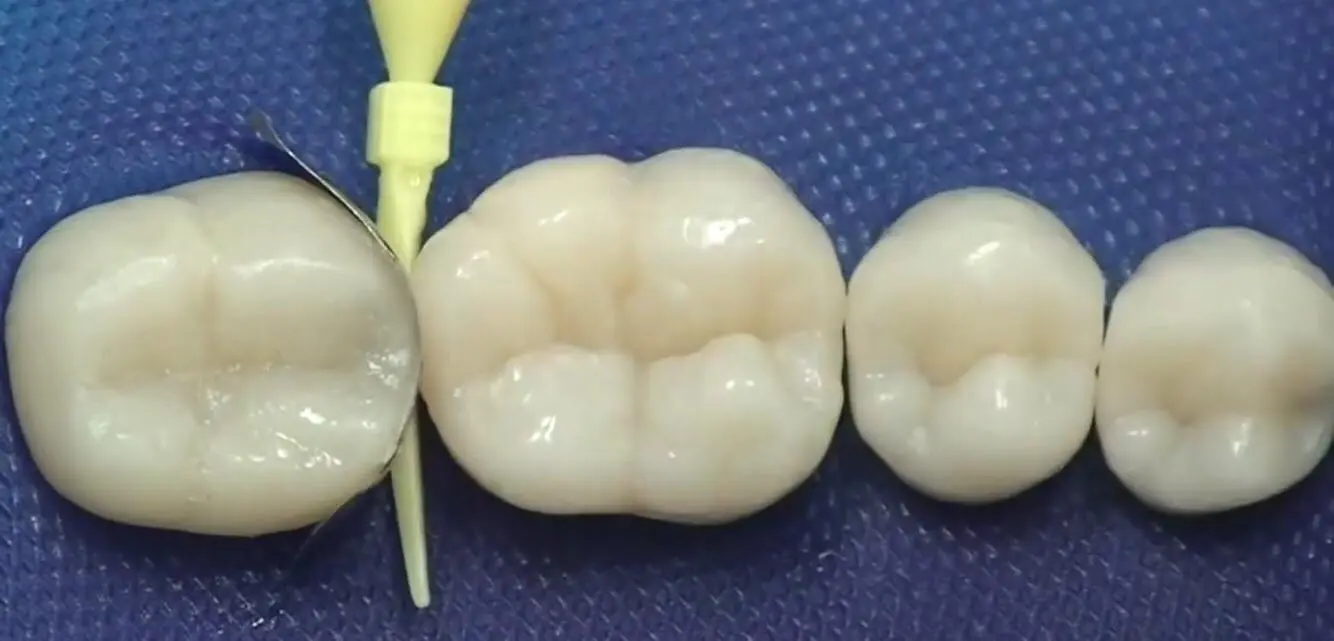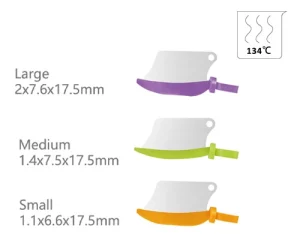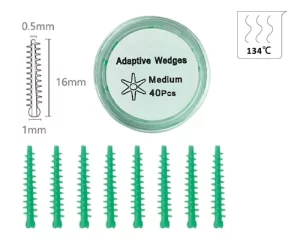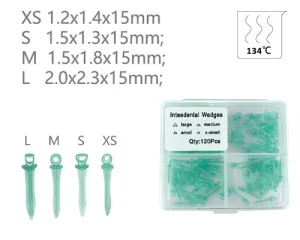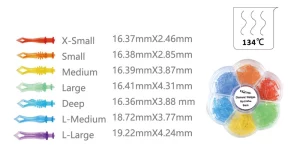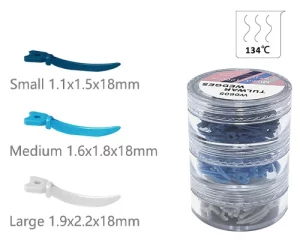Embora pequeno, As cunhas dentárias desempenham um papel insubstituível na odontologia restauradora. Eles são usados principalmente para separação dentária, Estabilizar bandas de matriz e moldar as bordas das restaurações. Dependendo do material e do design, O desempenho clínico e o uso de cunhas variam. Neste artigo, Analisaremos sistematicamente os tipos de Fuas dentárias, suas propriedades materiais, suas principais funções e sua aplicação no preenchimento e restauração.
1. Tipos de cunhas dentárias e propriedades do material
Cardas dentárias de plástico
Material: Frequentemente feito de polipropileno médico (Pp), flexível.
Vantagens:
- A elasticidade moderada reduz a pressão nas gengivas.
- Pode ser esterilizado em altas temperaturas e é adequado para reutilização.
Desvantagens:
- Suporte limitado, Não é adequado para casos com cárie profunda ou lacunas apertadas.
Exibição de amostra:
- guardas dentárias (GD-5675): com buraco com rblade
três tamanhos: Grande/média/pequena

- cunhas adaptativas (GD-5677): com núcleo plástico interno firme, coberto com silicone

- Resina cunhas dentárias (GD-5678): quatro tamanhos, XS/S/M/L.

- Custas de diamante (GD-5679): sete tamanho, X-small/pequeno/médio/grande/profundo/L-medium/L-largo

- TULWAR CABELAS (GD-5680): três tamanhos, Pequeno/médio/grande

Cascas dentárias de madeira
Material: Principalmente bétula ou pinheiro, esterilizado. Cunhas de bétula com um teor de água de 12% pode expandir até 18.7% em 30 minutos em um ambiente fluido gengival. Esta propriedade adaptativa os torna particularmente adequados para casos de recessão gengival em pacientes antigos. No entanto, Cuidado deve ser tomado: A excesso de expansão pode levar a pressão excessiva na membrana periodontal, desencadeando sensibilidade pós -operatória.
Vantagens:
- Naturalmente absorvente e inchado, Melhor ajuste para a lacuna intraoperativamente.
- Rígido, Adequado para o suporte de alta força das cavidades de classe II.
Desvantagens:
- Inutilizável, exagerta pode causar desconforto.
Exibição de amostras:

Outros tipos
- Cunha de metal: Cru, comumente usado para preparação completa da coroa ou cenários restauradores especiais.
- Cunha de silicone: macio e flexível, Adequado para restaurações estéticas, mas mais caro.
2. As três funções principais da cunha de dente
Separação de dentes
- Separa temporariamente os dentes vizinhos por 0.2-0.5 mm com força mecânica leve para criar um espaço operacional.
- Isso impede que a restauração seja pendente e restaure a forma natural dos pontos vizinhos.
- Estudos clínicos mostraram que o uso adequado das cunhas pode reduzir o risco de impactação alimentar até 60%.
Estabilização da banda da matriz
- Fuas dentárias podem ajudar a consertar a peça de moldagem, impedindo o vazamento do material restaurador e moldando o contorno ideal.
- Restaurações de cavidade II: a combinação com o Bandas Matrix A estabilização é a solução clássica.
- Restaurações de classe V: geralmente em combinação com uma placa de moldagem curva.
Proteção gengival e hemostasia
- As cunhas dentárias podem fornecer um certo grau de proteção acima das gengivas.
- Depois que a cunha dentária é inserida no dente, exercerá uma leve pressão na gengiva, reduzindo o sangramento durante a operação.
3. Habilidades de aplicação em preenchimento e reparo
Como escolher a cunha certa
| Critérios | Tipo de cunha recomendado |
|---|---|
| Espaço Interproximal estreito | Custas de madeira, ele se expande e se encaixa depois de se molhar |
| Amplo espaço interproximal | Cunha de plástico, ajuste elástico |
| Resina leve e curada | Cunhas de plástico transparente, facilitar a penetração da luz |
| Preenchimento de amálgama | Custas de madeira, pode oferecer um suporte mais forte |
Insira o ângulo e a direção
A cunha dentária deve ser inserida obliquamente no espaço interdental a partir do lado lingual ou bucal do dente, e o ângulo deve ser controlado em 30° a 45°. O objetivo principal deste design Angle é evitar o tecido gengival, evitar compressão direta ou arranhões na gengiva durante a inserção vertical, e reduzir o risco de vermelhidão gengival pós-operatória, inchaço e sangramento.
Controle de profundidade de inserção
O topo da cunha deve ser ligeiramente mais alto que a borda da restauração em aproximadamente 0,5 mm.. Este espaço reservado é projetado para compensar o encolhimento durante o processo de cura dos materiais de enchimento subsequentes (como resina), garantindo que o material possa aderir perfeitamente à borda do dente após a cura e evitando a formação de lacunas que poderiam levar a cáries secundárias.
Precauções clínicas
Evite pressão excessiva nas gengivas: Durante a operação, a força de inserção da cunha dentária deve ser controlada. A pressão excessiva pode danificar a relação de fixação entre as gengivas e os dentes, o que pode causar recessão gengival pós-operatória. As estatísticas clínicas mostram que a incidência de tais complicações é de aproximadamente 3% para 7%.
Posicionamento preciso da posição de inserção: Se a cunha dentária for inserida em uma posição deslocada (como estar muito próximo da superfície oclusal ou da direção da ponta da raiz), pode fazer com que os pontos de contato dos dentes adjacentes fiquem muito frouxos, afetando assim a estabilidade da relação oclusal normal. Os pacientes podem ter problemas como mordida fraca e impactação alimentar.
Caso real: Reparação de defeito profundo em forma de cunha
Tomando como exemplo o reparo de um defeito profundo em forma de cunha do primeiro pré-molar inferior esquerdo, a operação específica e o efeito terapêutico são os seguintes:
- Avaliação pré-operatória: O paciente era um adulto de 45 anos. O defeito cervical do primeiro pré-molar inferior esquerdo atingiu a dentina profunda, acompanhado por sintomas óbvios de sensibilidade ao frio e ao calor. A Escala Visual Analógica (SVA) foi usado para avaliar o grau de sensibilidade, com uma pontuação de 6/10.
- Principais técnicas de operação: Primeiro, use o Não. 00 linha gengival para tratamento de drenagem gengival. Então, insira uma cunha de pinho pré-umedecida e deixe repousar 15 minutos até que se expanda totalmente para ampliar a lacuna do dente. Próximo, resina fluida é usada como base, e então a resina 3M Z350XT é usada para enchimento em camadas. As cunhas devem ser retidas até que a resina esteja inicialmente curada antes de serem removidas para evitar a deformação do material durante o processo de preenchimento..
- Eficácia pós-operatória: O paciente foi acompanhado por um ano após a operação. O exame mostrou que a taxa de integridade da restauração atingiu 98%, sem afrouxamento, descolamento ou cárie secundária. Os sintomas de sensibilidade ao frio e ao calor do paciente desapareceram completamente, e a função oclusal voltou ao normal.
4. Critérios de compra para cunhas dentárias
Prioridade de segurança do material
Padrões básicos de certificação
O material e o tratamento de esterilização da cunha devem cumprir os padrões médicos profissionais. Diferentes materiais correspondem a requisitos de certificação claros:
- Custas de plástico: Deve ter FDA (Administração de Alimentos e Medicamentos dos Estados Unidos) ou CE (Certificação de Segurança de Produto da União Europeia) certificação de polímero de grau médico. O núcleo precisa evitar substâncias nocivas, como ftalatos, que podem migrar por contato e representar riscos potenciais à saúde. A certificação de conformidade é a base fundamental para garantir a segurança dos materiais.
- Custas de madeira: Um EO completo (óxido de etileno) relatório de esterilização deve ser fornecido, e o relatório deve indicar claramente que a carga biológica é ≤10⁻⁶ (Ou seja,, a probabilidade de sobrevivência microbiana após a esterilização não excede uma em um milhão), garantindo que não haja bactérias patogênicas remanescentes antes do uso para evitar infecção cruzada ou inflamação pós-operatória.
Pontos-chave para evitar armadilhas nas compras
Ao comprar, seja cauteloso com produtos não médicos e, especialmente, rejeite “cunhas de madeira industriais” sem nenhuma marcação. A maioria desses produtos é feita a partir de sobras de processamento industrial e não passou por tratamento médico.. Eles podem conter produtos químicos nocivos, como formaldeído. Quando usado, eles não apenas irritam facilmente o tecido gengival, mas também podem ser absorvidos pela mucosa oral, representando uma ameaça à saúde do paciente. Além disso, não existem padrões unificados para seu tamanho e dureza, que não pode atender aos requisitos precisos de operação da restauração dentária.
Maximize a taxa de ajuste de tamanho
Ao escolher cunhas, é necessário combinar as necessidades clínicas reais e maximizar a taxa de ajuste de tamanho através “avaliação pré-operatória + reserva multi-especificação”.
Antes da operação, o tamanho da cunha necessária deve ser determinado inicialmente com base na largura do espaço interdental do dente afetado (como a lacuna de cárie interdental, lacuna de defeito em forma de cunha) e a morfologia do dente (como dentes decíduos e dentes permanentes, dentes normais e dentes inclinados).
Recomenda-se estocar vários tamanhos de cunhas (como fino, médio, espesso, ou estilos finos e grossos para espaços dentários especiais) para evitar mau ajuste devido ao tamanho único insuficiente, o que pode afetar o efeito de abertura da lacuna ou causar compressão da gengiva. Isso garante que um modelo correspondente possa ser encontrado para diferentes casos, melhorando a eficiência operacional e a qualidade da restauração.
5. Conclusão
Embora as cunhas dentárias sejam pequenas e pareçam insignificantes, eles são indispensáveis “principais funções de apoio” em operações de restauração dentária. Da seleção de materiais ao uso padronizado, o controle preciso de cada link não é apenas a principal garantia para melhorar a estabilidade da restauração e reduzir complicações pós-operatórias, mas também pode efetivamente melhorar o diagnóstico e a experiência de tratamento do paciente e estabelecer uma base para um bom prognóstico a longo prazo.

